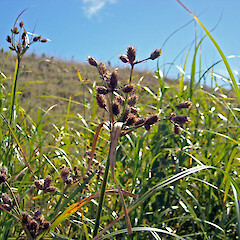Bolboschoenus fluviatilis
Common name
marsh clubrush, kukuraho, purua grass
Synonyms
Scirpus fluviatilis (Torr.) Gray; Scirpus maritimus var. fluviatilis Torr.; Scirpus perviridis Cook
Family
Cyperaceae
Flora category
Vascular – Native
Endemic taxon
No
Endemic genus
No
Endemic family
No
Structural class
Sedges
NVS code
The National Vegetation Survey (NVS) Databank is a physical archive and electronic databank containing records of over 94,000 vegetation survey plots - including data from over 19,000 permanent plots. NVS maintains a standard set of species code abbreviations that correspond to standard scientific plant names from the Ngä Tipu o Aotearoa - New Zealand Plants database.
BOLFLU
Chromosome number
2n = c.110
Current conservation status
The conservation status of all known New Zealand vascular plant taxa at the rank of species and below were reassessed in 2017 using the New Zealand Threat Classification System (NZTCS) – more information about this can be found on the NZTCS website. This report includes a statistical summary and brief notes on changes since 2012 and replaces all previous NZTCS lists for vascular plants.
Please note, threat classifications are often suggested by authors when publications fall between NZTCS assessment periods – an interim threat classification status has not been assessed by the NZTCS panel.
- Conservation status of New Zealand indigenous vascular plants, 2017 . 2018. Peter J. de Lange, Jeremy R. Rolfe, John W. Barkla, Shannel P. Courtney, Paul D. Champion, Leon R. Perrie, Sarah M. Beadel, Kerry A. Ford, Ilse Breitwieser, Ines Schönberger, Rowan Hindmarsh-Walls, Peter B. Heenan and Kate Ladley. Department of Conservation. Source: NZTCS and licensed by DOC for reuse under the Creative Commons Attribution 4.0 International licence.
2017 | Not Threatened | Qualifiers: SO
Previous conservation statuses
2012 | Not Threatened
2009 | Not Threatened
2004 | Not Threatened
Distribution
Indigenous.
Habitat
Coastal to lowland in saltmarshes and other poorly drained saline areas, also found along some freshwater rivers and lakes. Sometimes invades pasture abutting tidal streams and estuaries.
Wetland plant indicator status rating
Information derived from the revised national wetland plant list prepared to assist councils in delineating and monitoring wetlands (Clarkson et al., 2021 Manaaki Whenua – Landcare Research Contract Report LC3975 for Hawke’s Bay Regional Council). The national plant list categorises plants by the extent to which they are found in wetlands and not ‘drylands’. The indicator status ratings are OBL (obligate wetland), FACW (facultative wetland), FAC (facultative), FACU (facultative upland), and UPL (obligate upland). If you have suggestions for the Wetland Indicator Status Rating, please contact: [Enable JavaScript to view protected content]
OBL: Obligate Wetland
Almost always is a hydrophyte, rarely in uplands (non-wetlands).
Detailed description
Summer-green, bulbous perennial forming mostly densely clumped patches. Rhizome 7–9 mm diameter, woody, long-creeping, very dark brown, apices terminated by globose, ligneous tubers. Culms 1.5–2.5 m tall, 6–15 mm diameter, triquetrous, striated, smooth except just below inflorescence where scabrid on angles; basal sheaths loose, membranous, septate, brown to fawn, up to 150 mm long. Leaves numerous, ≤ or > culms, 500 × 7–11 mm, double-folded but flattened, grass-like, tapering, coriaceous, margins and midrib scabrid towards apices; sheaths long, closed, coriaceous. Inflorescence a terminal, compound, irregular umbel; rays 6–9, unequal, 20–100 mm long, bearing clusters of 1–6 spikelets, a sessile glomerule of spikelets at the base of the rays; involucral subtending bracts similar to leaves, > inflorescence, unequal, 150–250 × 3–6 mm, as many as, or 1–2 fewer than rays. Spikelets 10–25 mm long, ovoid, or cylindric, dull red-brown. Glumes membranous, pubescent, apices cleft or lacerate, with a scabrid, recurved awn. Hypogynous bristles 6, more or less equal to nut in length, persistent, red-brown, retrorsely scabrid. Stamens 3. Style-branches 3. Nut 3.0–4.0 × 1.5–2.0 mm, equilaterally 3-angled with acute dorsal angle, obovate, apiculate, pale cream, occasionally black and glossy.
Similar taxa
Bolboschoenus fluviatilis is the tallest of the three New Zealand species, and the one most likely to be found in freshwater systems. It differs from B. caldwellii (Cook.) Soják and B. medianus (Cook) Soják by the taller stature, conspicuously umbellate inflorescence with long, through irregular, rays, and distinctly trigonous nuts. B. fluviatilis has 3 rather than the 2 or 2–3 style branches typical of the other two species.
Flowering
October–January
Fruiting
December–May
Life cycle
Bristly nuts are dispersed by water and possibly wind (Thorsen et al., 2009).
Propagation technique
Easily grown from fresh seed and rooted pieces. Will grow in almost any soil but prefers a sunny, damp soil. Ideal as a pond plant or for planting along tidal streams.
Etymology
bolboschoenus: From Greek: bolbos (swelling or bulb) and schoinos (rush, reed), from the supposed difference from the genus Schoenus in having bulbous tubers
fluviatilis: From the Latin fluvius ‘river’, meaning growing near rivers
Cultural Use/Importance
Some inland occurrences in the Hamilton Basin (Waikato) peat lakes suggest that the species was planted deliberately for food by Māori.
Attribution
Description adapted from: Moore, L.B.; Edgar, E. 1970: Flora of New Zealand. Vol. II. Government Printer, Wellington.
References and further reading
Thorsen MJ, Dickinson KJM, Seddon PJ. 2009. Seed dispersal systems in the New Zealand flora. Perspectives in Plant Ecology, Evolution and Systematics 11: 285–309.







